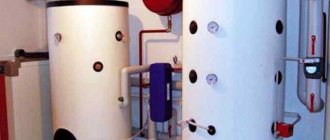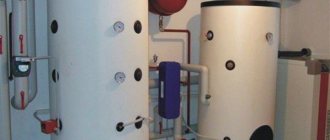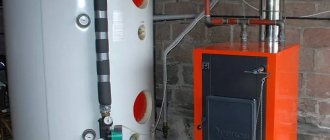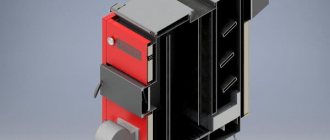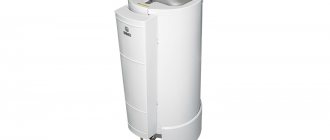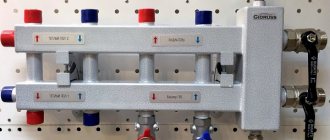When designing a heating system, the main goals are comfort and reliability. The house should be warm and cozy, and for this, hot coolant should always flow into the radiators without delays or temperature surges.
This is difficult to achieve with a solid fuel boiler, because it is not always possible to fill a new portion of firewood or coal on time, and the combustion process itself is uneven. A heat accumulator for heating boilers will help correct the situation.
With a simple design and operating principle, it can eliminate a number of inconveniences and disadvantages of the classical heating scheme.
Features of installing heat accumulators
All installation work is carried out according to a previously approved project in accordance with the recommendations of the heating equipment manufacturer.
In this case, it is necessary to take into account the features of installation work:
- The surface of the storage tank must be insulated from heat loss without fail.
- Thermometers should be installed on the pipelines through which water circulates (outlet and inlet).
- Battery containers with a volume of over 500 liters in most cases do not fit through the doorway. In such cases, you should use collapsible structures or install several smaller batteries.
- It would not hurt to install a drainage channel at the lowest point of the container. It will come in handy when you have to completely drain the water.
- It is advisable to install mesh filters on the pipelines through which water enters the container. They will prevent large inclusions from getting inside (welding scale, minerals trapped in the system, etc.).
- If there is no air vent valve at the top of the container, it should be installed at the top point of the outlet pipe.
- It is necessary to install a pressure gauge and a safety valve on the line next to the battery.
If you are the owner of a solid fuel boiler and have not yet purchased a heat accumulator, think about it. You will not only extend the life of your heating equipment, but also significantly save on fuel.
Homemade heat accumulator: advantages, design, connection diagram to the heating system
Among craftsmen, improving the heating system has recently become one of the most popular topics. The material used for the heat accumulator is 200 liter metal barrels, containers for technical fluids and even ready-made solutions - barrels from decommissioned fire trucks and army water-oil heaters. At the same time, the latter options are considered the most preferable - the containers already have thermal insulation and sufficient volume. So, from an AC-40 fire truck, the tank has a capacity of 1.5 tons, an army trailer holds 1 ton of water.
When designing, different calculation methods are used, but the fastest and easiest is to use an online calculator, into which you just need to substitute the requested indicators.
At the same time, despite the apparent simplicity of correctly calculating and installing a heat accumulator for a solid fuel boiler, it is also important to correctly select other equipment - pumps, valves, taps, electronic control devices.
Functionality of heat accumulators
The principle of operation of the equipment is that during operation of the boiler, part of the heat is used to heat the coolant from an additional tank. The connected tank has good thermal insulation and perfectly retains the resulting heat. After the boiler is turned off, the water in the heating system cools down, and the control devices turn on the pump that supplies hot water from the storage tank.
These cycles continue as long as the water temperature in the auxiliary tank remains high enough. The total duration of operation of the system without turning on the boiler depends on the volume of the additional capacity. In practice, it allows you to heat rooms from several hours to 2 days.
The heat accumulator performs the following functions:
- It accumulates heat coming from the system boiler and releases it over time to heat the rooms of the room.
- Prevents the possibility of boiler overheating by removing excess heat from the exchanger.
- Allows you to easily combine different heating devices (electric, gas, solid fuel) into a common system.
- Helps improve the performance of heating equipment, reducing fuel consumption and improving efficiency.
- In systems with solid fuel boilers, it eliminates constant monitoring of the condition of heating equipment. By heating the coolant in an additional container, homeowners can forget about the need to constantly load fuel into the boiler.
- It is a source of hot water for domestic needs.
Heating system diagram
How profitable a heating system with a heat accumulator is can be seen using this example.
Let's assume that a 10 kW boiler is installed in the heating system. Every 3 hours it is necessary to load firewood. This does not fit into the plans of the homeowners. To lengthen the breaks between loads, it is necessary to use a larger boiler. But in this case, the coolant may boil, since the system will not have time to remove all the generated heat.
Connecting a heat accumulator with a capacity of about 200 liters easily solves the problem. The equipment allows you to accumulate 110 kW of energy provided that the boiler is fully and frequently loaded. Subsequently, the accumulated heat will maintain a comfortable room temperature for about 10 hours. There is no need to load the boiler with fuel all this time.
Features of internal and external devices
The heat accumulator is a vertical cylinder-shaped tank made of high-strength black or stainless steel sheet.
There is a layer of bakelite varnish on the inner surface of the device. It protects the buffer tank from the aggressive influence of industrial hot water, weak salt solutions and concentrated acids. Powder paint is applied to the outside of the unit, resistant to high thermal loads.
The tank volume varies from 100 to several thousand liters. The most capacious models have large linear dimensions, making it difficult to place equipment in the limited space of a home boiler room
External thermal insulation is made of recycled polyurethane foam. The thickness of the protective layer is about 10 cm. The material has a specific complex weave and an internal polyvinyl chloride coating.
This configuration prevents particles of dirt and small debris from accumulating between the fibers, provides a high level of water resistance and increases the overall wear resistance of the heat insulator.
The heat insulator is not always included in the heat accumulator kit. Sometimes you have to buy it separately and then install it on the unit yourself
The surface of the protective layer is covered with a cover made of good quality leatherette. Thanks to these conditions, the water in the buffer tank cools much more slowly, and the level of overall heat loss of the entire system is significantly reduced.
What is a heat accumulator buffer tank and its purpose.
The purpose of a heat accumulator (TA) will be easier to describe using several example problems.
Task one. The heating system is based on a solid fuel boiler. There is no way to constantly monitor the temperature of the coolant in the supply and add firewood in a timely manner, as a result of which the supply temperature either exceeds what we need or drops below normal. How to ensure that the required coolant temperature is maintained?
Task two. The house is heated by an electric boiler. Electricity supply is two-tariff. How to reduce energy costs by reducing energy consumption during the day and increasing it at night?
Task three. There is a heating system in which heat is generated by heat generators running on various types of fuel and energy - e.g. gas, electricity, solar energy (solar collectors), earth energy (heat pump). How to ensure their efficient operation without loss of generated heat when there is no need for it, while at the same time providing the house with heat during periods of peak energy consumption?
Without going too much into the theory of heat engineering, for all problems a solution suggests itself in the form of installing a buffer tank in the system, which would serve as a reservoir for the coolant and in which its temperature would be maintained at a given level. The heat accumulator is precisely such a buffer capacity. To solve these problems, the heat accumulator is usually connected “into the gap” of the system to form the boiler and heating circuits. A schematic diagram for connecting a heat accumulator to a heating system is shown in the figure below.
Rice. Schematic diagram of switching on a buffer tank (heat accumulator)
Various ways to connect a buffer tank to a heating system can be found in the article “Heat accumulator connection diagrams”.
Currently, heat accumulators are most often used in heating systems with solid fuel boilers. In these systems, the use of a heat accumulator makes it possible to load fuel less frequently and provide a comfortable supply of heat regardless of fluctuations in the coolant temperature at the boiler outlet. Often, buffer tanks are installed with electric boilers to save money due to a reduced night tariff and in combined systems with the simultaneous use of solid fuel and electric boilers. A heat accumulator (TA) can be useful in systems with gas boilers, especially when the minimum thermal power of the boiler exceeds the thermal load of the facility. Due to longer periods of “loading” the heat exchanger (heating the coolant), it is possible to avoid “clocking” the boiler.
In addition to being used as a buffer tank, the TA serves as a hydraulic separator. This property of a heat accumulator is especially in demand in systems with heat generators operating on different types of energy (including alternative). As a rule, these heat sources operate on special coolants that do not allow mixing with other types and require a unique temperature and hydraulic regime, often incompatible with the heating circuit modes (radiator, heated floor). For example, the temperature range of a heat pump is typically
5°C, and in the heat distribution circuit the temperature range can be much larger (10-20°C). To separate the circuits, the heat accumulator can be equipped with additional built-in heat exchangers.
The operating principle of a heat-saving product
The heat accumulator operates according to the simplest scheme. A pipe from a gas, solid fuel or electric boiler is connected to the unit from above.
Hot water flows through it into the storage tank. Cooling down during the process, it falls down to the location of the circular pump and, with its help, is fed back into the main passage to return to the boiler for the next heating.
Installing a heat accumulator prevents overheating of the coolant when the boiler is operating at full power and ensures maximum heat transfer with economical fuel consumption. This reduces the load on the heating system and extends its service life
A boiler of any type, regardless of the type of fuel resource, operates in steps, periodically turning on and off when the optimal temperature of the heating element is reached.
When work stops, the coolant enters the reservoir, and in the system it is replaced by hot liquid that has not cooled due to the presence of a heat accumulator. As a result, even after the boiler is turned off and goes into passive mode until the next fuel supply, the batteries remain hot for some time, and warm water comes out of the tap.
How to calculate the volume of a heat accumulator
If you wish, you can easily find methods for calculating the volume of a heat accumulator on the Internet, but none of them suited me.
Some “experts” recommend multiplying the maximum power of the existing boiler in kilowatts by some coefficient, and this coefficient on different sites differs by a factor of two or more - from 25 to 50. In my opinion, this is complete nonsense. Simply because the result obtained has nothing to do with your specific home or your wishes of how often you want to heat the boiler.
The normal method takes into account all factors: the climate in your area, the thermal insulation of the house, and your ideas about comfort. In a good way, this calculation will also need to be carried out many times for different temperature conditions, and the maximum volume of the heat accumulator must be selected. And, by the way, the power of the boiler in the correct method is obtained as a result of calculations, and not according to the principle “what it was, that’s how it was installed.” But all this is quite complicated, and is more suitable for boiler houses, rather than for private households.
I did it much simpler. I calculated the heat accumulator for a solid fuel boiler as follows.
- It is necessary to estimate the amount of heat that the house requires per day. This is the most difficult and responsible part of the work. Again, you can go deeper into the calculations (you can find all the necessary techniques in textbooks for construction universities). But, if possible, it is easier and more reliable to carry out a direct measurement - simply by heating the house in cold weather and measuring the amount of fuel used. My house is relatively small - a little less than 100 square meters. m, and quite warm. Therefore, it turned out that when the outside temperature is about 0 degrees, to maintain a comfortable temperature, a solid reserve of 50 kWh is required, for - 10 degrees - 100 kWh, for - 20 degrees - 150 kWh.
- Choosing a boiler is very simple. The most common boilers have a power of about 25 kW and with one maximum load they provide this power for about 3 hours. Therefore, one kindling provides about 75 kWh of heat. For zero temperatures, therefore, even one full load will be too much for me. And for -20 degrees, it will be enough to heat it 2 times a day. I was quite happy with this option.
- Now the actual volume of the heat accumulator. The heat capacity of water is 4.2 kJ per liter per degree. The maximum temperature in the heat accumulator is 95 degrees, the comfortable water temperature in the heating system is 55 degrees. That is, 40 degrees difference. In other words, 1 liter of water in a heat accumulator can accumulate 168 kJ of heat, or 46 Wh. And 1000 liters, respectively - 46 kWh. It follows that in order to retain heat from one full load of the boiler, I need a heat accumulator with a capacity of 1500 liters. This is all with reserve. In fact, a little less is required, but after studying the prices of buffer containers, I decided to ignore this.
This calculation means that in severe frosts I have to heat the boiler twice a day, and in very severe frosts - three times. Moreover, this should be done evenly throughout the day: in the morning and evening or in the morning, at the beginning of the evening and before bed. And when there is no severe frost, I heat the boiler only once - at any time of the day.
Of course, if you install a heat accumulator with an even larger volume, you can make your life even more comfortable. But here you have to face the fact that a large barrel requires a lot of space.
Advantages and disadvantages
A heating system with a heat accumulator, in which the heat source is a solid fuel unit, has a lot of advantages:
- Increasing comfortable conditions in the house, since after the fuel is burned, the heating system continues to heat the house with hot water from the tank. No need to get up in the middle of the night and load a portion of firewood into the firebox.
- The presence of the container protects the boiler water jacket from boiling and destruction. If the electricity is suddenly turned off or the thermostatic heads installed on the radiators turn off the coolant because the desired temperature has been reached, the heat source will heat the water in the tank. During this time, the electricity supply may be restored or the diesel generator will be started.
- The supply of cold water from the return pipeline to the hot cast iron heat exchanger is excluded after the circulation pump is suddenly turned on.
- Heat accumulators can be used as hydraulic separators in a heating system (hydraulic arrows). This makes the operation of all branches of the circuit independent, which provides additional savings in thermal energy.
The higher cost of installing the entire system and the requirements for equipment placement are the only disadvantages of using storage tanks. However, this investment and inconvenience will be followed by minimal operating costs in the long run.
We recommend:
How to make heating in a private house - a detailed guide How to choose an expansion tank for a heating system How to select and connect a membrane expansion tank
Russian made
There are not many domestically produced heat accumulators on the Russian market, since only recently they began to be actively introduced into autonomous heating systems.
| Model | Additional options | volume, m3 | Operating pressure, bar | Maximum temperature, ºС | Approximate cost, rub |
| Sibenergo-therm | — | 0.5 | 6 | 90 | 28500 |
| PROFBAK TA-VV-500 | DHW circuit | 0.5 | 3 | 90 | 56000 |
| GidroNova-HA750 | Electric heating element | 0.75 | 3 | 95 | 58000 |
| ELECTROTHERM ET 1000 A | DHW circuit, additional heat exchanger | 1.0 | 6 | 95 | 225000 |
Calculation of heat accumulator capacity
The method by which the calculation is made may vary depending on the application scheme. Here is an approximate calculation scheme:
- Determination of maximum fuel load. For example, the firebox can hold 20 kg of firewood. 1 kg of firewood can release 3.5 kWh of energy. Thus, when burning one stack of firewood, the boiler will produce 20·3.5=70 kWh of heat. The time it takes for a full bookmark to burn can be determined empirically or calculated. If the boiler power is, for example, 25 kW 70:25 = 2.8 hours.
- Coolant temperature in the heating system. If the system is already installed, it is enough to measure the temperature at the inlet and outlet and determine the heat loss.
- Determining the desired download frequency. For example, it is possible to load in the morning and evening, but it is not possible to service the boiler during the day and at night.
Heat accumulator calculation
If, for example, the heat loss of a room per hour is 6.7 kW, then per day it will be 160 kW. In the example under consideration, this amounts to little more than two loads of fuel. As defined above, one load of firewood burns for about 3 hours, releasing 70 kWh of thermal energy.
The need for heating the house is 6.7·3=20.1 kWh, the storage tank reserve will be 70-20.1=49.9, that is, approximately 50 kWh. This energy is enough for a period of 50:6.7 - this is about 7 hours. This means that two full nests and one incomplete one are required per day.
Based on these calculations, having considered several options, we settle on this: at 23:00 a partial load is made, at 6:00 and 18:00 – full. If you draw a graph of the charge level of the heat accumulator, you can see that the maximum charge is 60 kWh at 9 am.
Since 1 kW·h=3600 kJ, the reserve should be 60·3600=216000 kJ of thermal energy. Temperature reserve (difference between the maximum water indicator and the required supply indicator) 95-57 = 38°C. The heat capacity of water is 4.187 kJ. Thus, 216000/(4.187·38)=1350 kg. In this case, the required volume of the heat accumulator will be 1.35 m3.
The considered example gives a general idea of how the capacity of a storage tank is calculated. In each individual case, it is necessary to take into account the characteristics of the heating system and its operating conditions.
Features of installing a heat accumulator
Before installing the equipment, a detailed design must be drawn up. It is necessary to take into account all the requirements of heating equipment manufacturers. When installing a storage tank, the following rules must be observed:
- The surface of the container must have reliable thermal insulation.
- Thermometers should be installed at the inlet and outlet to monitor the water temperature.
- Bulk tanks most often do not fit into the doorway. If it is not possible to bring in the tank before construction is completed, you will have to use a collapsible version or several smaller tanks.
- It is desirable to have a coarse filter on the inlet pipe.
- A safety valve and pressure gauge should be installed next to the tank. The tank itself should also have an air vent valve.
- It must be possible to drain water from the tank.
The use of a heat accumulator in a system with a solid fuel boiler increases the efficiency of the heat generator and its service life, and also allows for more economical fuel consumption. The possibility of adding fuel more rarely makes using the heating boiler more convenient for the consumer. Calculation of the required capacity of the storage tank must take into account the type of boiler, the features of the heating system and its operating conditions.
Despite the simplicity of the device and the obvious benefits of using heat accumulators, this type of equipment is not yet very widespread. In this article we will try to talk about what a heat accumulator is and the benefits that its use in heating systems brings.
Making a solid fuel boiler with your own hands
A solid fuel boiler for a private home can theoretically be made independently. To do this, you need to take a large 300 mm pipe, from which a meter-long piece is cut. You need to cut the bottom from a steel sheet according to the diameter of the pipe and weld the elements. The legs of the boiler can be 10-centimeter channels.
When making a solid fuel boiler for a private home, you will need to make an air distributor in the form of a circle from a sheet of steel. Its diameter should be 20 mm smaller than the pipe. An impeller from a corner must be welded into the lower part of the circle. The size of its shelf should be 50 mm. A channel with the same dimensions is also suitable for this. A 60 mm pipe should be welded into the central upper part of the distributor, which should be located above the boiler. A hole is made in the middle of the distributor disk through the pipe to form a through tunnel. It is necessary for air supply.
A damper is attached to the top of the pipe, which will regulate the air supply. If you are faced with the question of how to make a solid fuel boiler, then you should familiarize yourself with the technology. The next stage indicates the need to complete the lower part of the equipment, where the door to the ash pit will be located. Holes are cut at the top. At this point a 100 mm pipe is welded. At first it will go at a certain angle to the side. Then up 40 cm, and then strictly vertically. The chimney passage through the ceiling must be protected according to fire safety rules.
Completion of the boiler is accompanied by work on the top cover. In its central part there should be a hole for the distributor pipe. The fit to the wall of the equipment must be tight. Air ingress is excluded here.
Having made a long-burning solid fuel boiler using wood, you will have to light it for the first time. To do this, remove the lid, lift the regulator, and fill the equipment to the top. Fuel is doused with flammable liquid. A burning splinter is thrown inside through the regulator pipe. As soon as the fuel ignites, the air flow will need to be reduced to a minimum so that the wood begins to smolder. As soon as the gas ignites, the boiler will start.
Application of heat accumulators
There are several methods for calculating tank volume. Practical experience shows that on average, for every kilowatt of heating equipment power, an additional 25 liters of water are needed. The efficiency of solid fuel boilers, which includes a heating system with a heat accumulator, increases to 84%. By leveling combustion peaks, up to 30% of energy resources are saved.
When using tanks to supply domestic hot water, there are no interruptions during peak hours. At night, when needs are reduced to zero, the coolant in the tank accumulates heat and in the morning again provides all needs in full.
Reliable thermal insulation of the device with polyurethane foam (polyurethane foam) allows you to maintain the temperature. Additionally, it is possible to install heating elements, which helps to quickly “catch up” with the desired temperature in case of emergency.
Heat accumulator in section
Heat storage is recommended in the following cases:
- great need for hot water supply. In a cottage where more than 5 people live and two bathrooms are installed, this is a real way to improve living conditions;
- when using solid fuel boilers. Batteries smooth out the operation of heating equipment during peak hours, remove excess heat, preventing boiling, and also increase the time between refills of solid fuel;
- when using electrical energy at separate tariffs for daytime and nighttime;
- in cases where solar or wind batteries are installed for storing electrical energy;
- when used in the heat supply system of circulation pumps.
This system is perfect for rooms heated with radiators or underfloor heating. Its advantages are that it is able to accumulate energy received from various sources. A combined energy supply system allows you to choose the most optimal option for obtaining heat for a given period of time.
Connection diagrams
Complete TA connection diagram for the heating system
The simplest connection diagram assumes the presence of a boiler heating circuit ring. This will make it possible to reduce the heating time of the main circuit. The thermostat will not allow cold coolant (water or glycol) to pass through the heat accumulator until the temperature is established at the required level.
As soon as this happens, the coolant is distributed in two directions:
- Warming up the TA.
- Warming up the main tank.
In the latter case, it is assumed to be mixed with the coolant and redirected to the tank. This increases efficiency and reduces the warm-up time of the main circuit. This connection allows the system to operate autonomously (with the pump turned off).
A separate circuit communicates with the TA and radiators. To eliminate the need to control the operation of the heating system, two bypasses are introduced into its structure:
- Contains a ball valve that closes when the pump is off. The check valve is activated.
- If the pump is stopped and the ball valve is out of order, the coolant is pumped through the second (backup) bypass.
The circuit can be simplified by eliminating the check valve. This is done on the basis that it is characterized by high flow resistance. When taking this step, you need to remember that in the event of a power outage, you will have to manually open the ball valve.
A more complex system using an alternative energy source and a hot water circuit
If outages are possible, an alternative power source or uninterruptible power supply is included in the system. This will require additional costs. The feasibility of purchasing this equipment appears after calculating the cost of pipes, fittings, pumps and valves, which may become unusable. As a result, purchasing a UPS (uninterruptible power supply) does not seem too expensive.
Detailed video review of the system
Design features of the heat accumulator
The device is a cylindrical container made of stainless steel or black steel. The dimensions of the container depend on its volume, which varies from several hundred to tens of thousands of liters. Due to its large volumes, it is difficult to place such a device in an existing boiler room, so it is often necessary to expand it. There are models with factory thermal insulation and containers without it.
When installing a heat accumulator, you need to take into account that the thickness of the insulation is 10 cm. After it, a leather casing is placed on top of the tank. Inside the container there is a coolant, which, when fuel is burned in the boiler, quickly heats up and retains heat for a long time due to the insulation layer. After the boiler stops operating, the storage tank releases its heat into the room, heating it. For this reason, it will not be necessary to light the boiler as often as before.
According to their design, heat accumulator capacities are:
- with a boiler located inside. This design was created to provide housing with hot water from an autonomous source;
- with one or two heat exchangers;
- empty (without coolant).
Threaded holes are provided to connect the storage device to the boiler and home heating system.
How to make it yourself
The easiest way to make a heat accumulator for heating with your own hands involves having a ready-made steel barrel.
Barrel for heat accumulator
If the required container is not available, then it must be welded from steel sheets, the thickness of which should be 2 mm. If the heat accumulator is connected as a hydraulic separator, then two fittings must be inserted from below and two from above; the length of these devices must be identical to the thickness of the insulation. Tees with thermometers must be connected to the lower pipes. Next, the barrel needs to be wrapped in foil, and then with insulation.
As insulation, it is important to use a material that, when in contact with hot surfaces, does not emit toxic fumes. The last stage: the container, previously lined with a heat insulator, is covered from the outside with a casing made of thin sheet steel or tin
If the heat accumulator is used in parallel to heat hot water, then it is necessary to make another coil. The material is a copper pipe with a diameter of 20 mm.
Another method that ordinary people prefer is to make a heat accumulator from a Eurocube with a capacity of 1000 liters. It is recommended to use Eurocubes, the high quality of which is confirmed by an international quality certificate.
Before you start making a thermal accumulator from a Eurocube, you should remember that the temperature of the liquid that will be in such a tank should not exceed 72°C, therefore standard Eurocubes are not suitable for heating systems with high temperatures.
In order to independently build a heat accumulator from a Eurocube, you need the following materials:
- Eurocube made from food materials;
- heating element 3000 W, 3 pieces;
- foot with gaskets G2″ to G1″1/4, 5 pieces;
- coupling D32 - G1 1/4″, 2 pieces;
- adapter adapter G1″1/4, 2 pieces;
- lock nut G1″1/4, 5 pieces;
- bend G1″1/4 30 cm, 2 pieces;
- plumbing flax or special paste;
- sealant;
- cardan key.
Heat accumulator made of Eurocube 1000 l
Assembly is carried out in the following way:
- Using a drill in the container body, you need to make an insert for the heating elements, then insert the fittings into the holes using gaskets and silicone glue-sealant, secure the fittings from the inside with locknuts and install the heating elements.
- Then it is necessary to ensure the supply of water to the heat exchanger, this is done using a standard drain neck through adapters.
- The next stage: the “return” is cut into the upper part of the Eurocube and connected, after which you need to mark the place for the cut-in and installation of the heat exchanger, as well as cut in the fittings and screw the fittings into them.
- On the inside of the ejectors, you need to screw the couplings to connect the corrugation, then secure it and distribute it evenly throughout the volume of the heat accumulator for heating.
- When connecting a heat accumulator, you need to install an EPS sheet at the installation site of the device, the thickness of which should be 10 cm, and also lay a 15 cm thick PSB along the rear wall.
The heat accumulator is insulated using a 10-centimeter sheet of polystyrene foam. It needs to be glued to the body of the Eurocube.
In addition to solid fuel boilers, using a heat accumulator is beneficial for gas and electric heating devices:
- Using gas boilers, savings are achieved due to the variable use of the heat accumulator and the boiler itself. In this case, gas is consumed in smaller quantities, since the gas burner is turned on much less often.
- For electric boilers, it is enough to turn on the heat accumulator at full power only at night, since electricity tariffs are much lower at this time. During the daytime, when the boiler is turned off, heating is carried out using the heat that has accumulated during the night.
The heat accumulator has no moving mechanical elements and its operation is static. This means that this device is reliable and long-lasting in use.
Background
It so happened that some time ago I purchased a private house at some distance from civilization. The distance from civilization is determined mainly by the fact that there is no gas there in principle. And the permitted power of the electrical connection does not provide the technical ability to heat the house with electricity. The only real source of heat in winter is the use of solid fuel. In other words, the house was equipped with a stove, which the previous owner heated with wood and coal.
If someone has experience using a stove, then they do not need to explain that this activity requires constant monitoring. Even in not too cold weather, it is impossible to put wood in the stove once and “forget” about it. If you put too much wood in, the house will become hot. And after the fuel burns out, the house will still cool down quickly. Willy-nilly, to maintain a comfortable temperature you need to constantly add firewood little by little. And in severe frosts the oven cannot be left unattended even for 3-4 hours. If you don’t want to wake up in the morning in a cold room, be kind enough to go to the stove at least once a night...
Of course, I had no desire to work as a fireman. And so I immediately began to think about a more convenient heating method. Of course, if it was impossible to use gas or electricity, this method could only be a modern solid fuel heating system, consisting of a solid fuel boiler, a heat accumulator and simple automation for turning the recirculation pump on and off.
Why is a modern boiler better than a conventional stove? It takes up much less space, you can put more fuel in it, it ensures better combustion of this fuel at maximum load, and theoretically with its help you can leave most of the heat in the house rather than release it into the chimney. But unlike a stove, a solid fuel boiler is practically impossible to use without a heat accumulator. I am writing about this in such detail because I know many people who tried to heat their houses with such boilers, connecting them directly to the heating pipes. They didn't do anything good.
What is a heat accumulator or, as it is also called, a buffer tank? In the simplest case, it is simply a large barrel of water, the walls of which have good thermal insulation. The boiler heats the water in this barrel during its two to three hours of operation. And then this hot water circulates through the heating system until it cools down. As it cools down, the boiler needs to be lit again. The simplest heat accumulator can be easily made by any welder. But after some thought, I abandoned this idea and bought a ready-made one. Since I live in Ukraine, I turned to it and have never regretted it: here they make storage tanks professionally and of very high quality.
Depending on the volume of the heat accumulator, the power of the boiler and how much heat the house needs, the boiler does not have to be heated constantly, but once or twice a day, or even once every two or three days.
Advantages and disadvantages
You can install a heat accumulator, which has boiler functions.
Advantages of using a heat accumulator:
- Retains thermal energy for hours and days.
- Overheating of the boiler is avoided.
- Thermal energy is not wasted, but is accumulated to be used in the future, thanks to this the efficiency of the boiler and the heating system as a whole increases.
- Allows you to save money.
- The air temperature in the rooms is easily maintained at the optimal level, sudden temperature changes are excluded.
- There is no need for frequent fuel loading.
- In addition to a solid fuel boiler, you can install a solar system, which is a free source of thermal energy.
- Some models of thermal accumulators for heating can combine the functions of a boiler.
Disadvantages of the system:
- Long heating - optimal installation in houses intended for permanent residence. In country cottages that are visited on weekends in winter, such a device will not be of any use.
- High cost - they cost about the same as the boiler, and sometimes more.
- Significant dimensions and weight - because of this, certain difficulties arise during transportation and installation. In addition, a heat accumulator intended for heating is installed in close proximity to the boiler; additional equipment must also be located there, so it is often necessary to allocate a special room for installing devices and prepare it in a special way: to equip a support platform capable of supporting the weight of the accumulator. When filled, the tank can weigh 3-4.
- A high-power boiler is required - the purchase of a storage tank is justified if the boiler’s power is not fully used; there is at least a double power reserve, otherwise the device will be inactive.
You can make a heat accumulator with your own hands from stainless steel and copper pipe.
By making a heat accumulator with your own hands, you can save a significant amount. The simplest design is made from a stainless steel barrel or even stainless steel sheet with a thickness of at least 3 mm. You will also need a copper tube with a diameter of 3 cm and a length of 14 m. It is bent into a spiral and placed inside the tank. A cold water supply is made from below, a hot water outlet is made from above, and shut-off valves are installed on the outlets. It is imperative to insulate a heat accumulator made by yourself for a solid fuel boiler, otherwise it will be ineffective. It is also necessary to install pressure and temperature sensors.
If you can’t weld a cylindrical container, you can make a heat accumulator for heating in the shape of a parallelepiped - it’s easier to make a tank of this shape with your own hands. The corners are further strengthened, and the structure is supplemented with stiffening ribs from the outside - they are welded at a distance of 30-35 cm from each other. The ratio of the diameter and height of the device is 1:3(4).
Calculation of the volume of the boiler buffer tank
The most optimal solution to this task would be to entrust its implementation to heating engineers. Calculating the volume of a heat accumulator for the entire heating system of a private house requires taking into account various factors known only to them. Despite this, you can make preliminary calculations yourself. To do this, in addition to general knowledge of physics and mathematics, you will need a calculator and a blank sheet of paper.
We find the following data
:
- boiler power, kW;
- time of active fuel combustion;
- thermal power of heating the house, kW;
- boiler efficiency;
- temperatures in the supply and return pipes.
Let's look at an example of a preliminary calculation. Heated area - 200 m2. Active burning time of the boiler - 8 hours, coolant temperature during heating - 90° C, in the return circuit - 40° C. The estimated thermal power of the heated rooms is 10 kW. With such initial data, the thermal device will receive 80 kW (10×8) of energy.
We calculate the buffer capacity of a solid fuel boiler based on the heat capacity of water
:
where: m – mass of water in the container (kg); Q – amount of heat (W); ∆t – difference in temperature of water in the supply and return pipes (°C); 1.163 – specific heat capacity of water (W/kg °C) .
Calculation of the buffer capacity of a solid fuel boiler
Substituting the numbers into the formula, we get 1375 kg of water or 1.4 m 3 (80000/1.163 × 50). Thus, for a heating system in a house with an area of 200 m2, it is necessary to install a heat accumulator with a capacity of 1.4 m3. Knowing this figure, you can safely go to the store and see which heat accumulator is acceptable.
Dimensions, price, equipment, manufacturer are already easily determined. By comparing known factors, it is not difficult to make a preliminary choice of a heat accumulator for your home. This calculation is relevant when the house is built and the heating system is already installed. The result of the calculation will show whether it is necessary to disassemble the doorways due to the dimensions of the TA. Having assessed the possibility of installing it in a permanent place, the final calculation of the heat accumulator for the solid fuel boiler installed in the system is made.
Having collected data on the heating system, we perform calculations using the formula
:
where: W is the amount of heat required to heat the coolant; m is the mass of water; c is the heat capacity; ∆t is the water heating temperature;
In addition, you will need the value k - boiler efficiency.
From formula (1) we find the mass:m = W/(c×∆t) ( 2 )
Since the efficiency of the boiler is known, we refine formula (1) and obtain W = m×c×∆t×k ( 3 ) from where we find the updated mass of water m = W/(c×∆t×k) ( 4 )
Let's look at how to calculate a heat accumulator for a home. The heating system is equipped with a 20 kW boiler (indicated in the passport data). The fuel fill burns out in 2.5 hours. To heat a house you need 8.5 kW/1 hour of energy. This means that during the burning time of one bookmark, 20 × 2.5 = 50 kW will be obtained
8.5 × 2.5 = 21.5 kW will be spent on space heating
The excess heat produced 50 – 21.5 = 28.5 kW is stored in the heat exchanger.
The temperature at which the coolant is heated is 35° C. (The difference in temperature in the supply and return pipes. Determined by measurements during operation of the heating system). Substituting the required values into formula (4) we obtain 28500/(0.8×1.163×35) = 874.5 kg
This figure means that to preserve the heat generated by the boiler, you need to have 875 kg of coolant. To do this, you will need a buffer tank for the entire system with a volume of 0.875 m3. Such lightweight calculations make it easy to select a heat accumulator for heating boilers.
Advice. For a more accurate calculation of the volume of the buffer tank, it is better to contact specialists.
Top 5 best heat accumulators
______________________________________________________________________________________
| Model | Characteristic | Advantages |
| S-TANK AT PRESTIGE – 500 (Belarus) | Weight – 105 kg. Diameter – 78 cm. Height – 157 cm. Tank volume – 500 l. | · ease of maintenance and easy installation; · water heats up quickly; · protected from overheating; · multifunctionality; · compatible with different heat sources. |
| HAJDU PT 300 (Hungary) | Height – 1595 mm. Weight – 87 kg. Tank volume – 300 l. | · works in a closed system, with pumps, thermal and solar panels; · you can install heating elements; · simple installation, design and maintenance; · good thermal insulation. |
| HAJDU AQ PT 1000 (Hungary) | Tank volume – 750 l. Weight - 93 kg. Diameter – 79 cm. Height – 191 cm. | · ergonomics; · presence of thermal insulation; · removable insulation and casing; · compatibility with various boilers; · long-term operation. |
| S-TANK AT AT-1000 (Belarus) | Weight – 131 kg. Height – 2035 mm. Diameter – 92 cm. Tank volume – 1000 l. | · the device is thermally insulated on top (70 mm); · for convenient connection, the pipes are rotated at an angle of 90° and located at different heights; · there are 4 0.5-inch holes for thermostatic pressure gauges and sensors. |
| S-Tank AT 300 (Belarus) | Weight – 65 kg. Height – 1545 mm. Diameter – 500 mm. Tank volume – 300 l. | · goes well with any type of boiler; · insulation has high fire resistance; · the tank is protected from the outside by casing (plastic or fabric, · The top of the tank is painted with heat-resistant paint. |
______________________________________________________________________________________________ Heat accumulators for heating boilers made in Russia have proven themselves well in the market. They are not inferior to foreign analogues; they also have high quality and a long service life, and the price is much lower. Well-known models of protective devices are produced by the following brands: “Prometey”, “Vodosistema”, “BTS”, “Gorynya”, LLC “RVS-engineering”, “Teplodar” .
